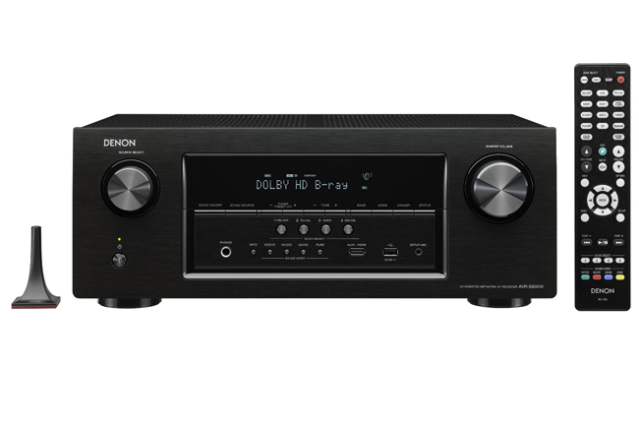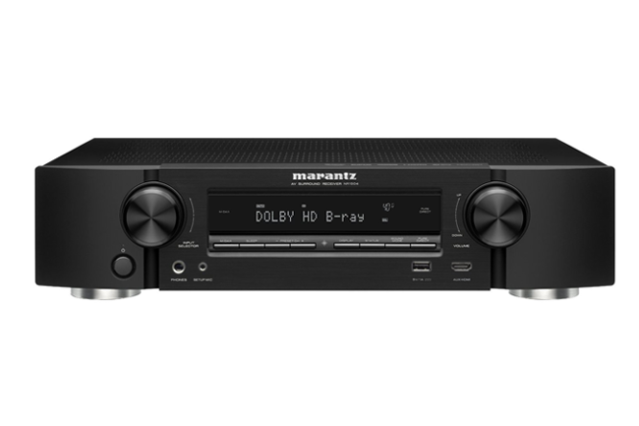It’s downright incredible how much A/V receiver you can get for under $500 these days. No longer does a $500 ceiling mean a trip to budgetville to pick up a black box of compromise and dashed dreams. Today’s low-priced receivers offer HDMI inputs in spades, Bluetooth audio streaming, 7.1 surround sound processing, and, yes, some of them even come with a phono pre-amp built in for that new turntable you’ve been eye-balling.
Of course, not all sub-$500 receivers are created equal — some are more style than substance, and, naturally, some will sound better than others. With that in mind, we’ve drummed up a list of our favorite A/V receivers, starting with our number one pick for the best of the bunch.
The Best
Onkyo TX-NR727 ($570)

Simply put, you will not find a better combination of features and solid sound quality under the $500 mark. Onkyo packs its patented high-current power supply into a sexy black chassis featuring 110 watts per channel, 7.2 surround sound support, Zone 2 audio for music in a separate room, 8 HDMI inputs, a phono input, Bluetooth, and Wi-Fi for streaming supported Internet radio services such as Spotify, Pandora and Rhapsody. The only fancy feature you won’t find is support for Apple’s AirPlay – which may or may not mean much to you, depending on your love for Apple’s ecosystem.
You’ll want to do a manual speaker calibration for the best possible sound quality, as the built-in auto set-up system delivers consistently inconsistent results, but that’s par for the course at this price point. Buy with confidence, as Onkyo delivers reliably rock-solid gear, year after year, and is routinely at the top of our recommendations. Check out the brand-new Onkyo TX-NR636, which is a step down in power and HDMI inputs, but sports Dolby Atmos surround support, 4K video passthrough, and High-Res audio support.
Available at:
The Rest
Denon AVR-S900W ($500)

This receiver packs a lot at a mid-level price point. Armed with 90-watts x 7 channels, Ultra HD/4K passthrough, HDMI 2.0, and support for Bluetooth, Wi-Fi and Airplay, the S900W is one of the most budget-friendly A/V receivers around. What’s more, the simple setup with graphical menus takes only minutes.
Available at:
Yamaha RX-V577 ($430+)

The mid-level Yamaha receiver gets a lot right. The less expensive of the two 7.2 channel models from Yamaha is equipped with Wi-Fi, Airplay, HTC Connect, High-Res Audio playback, HDMI ARC support, Spotify Connect and Pandora. This could easily be the center of any home theater, and it’s second only to the Onkyo in terms of sound quality.
Available at:
Sony STR-DN1040 ($700)

At under $400, the Sony STR-DN1040 has the spirit of a premium receiver but is designed for those on a budget. With 8 HDMI inputs, one on front for MHL. robust networking features including AirPlay, Bluetooth, and Wi-Fi, this device is built to satisfy. The smart looks are an additional bonus as well.
Available at:
Marantz NR-1504 ($349+)

Slim but powerful, this may be the best option for those frustrated by the nearly ubiquitous bulky design of most AV receivers. 50 watts per channel at 5.1 output (conservative rating means real-world performance equal to others on this list) and 6 HDMI inputs. Built-in networking will interface with Airplay, Pandora, and Spotify. Oh, and don’t forget the classic, warm Marantz sound.
Available at:
Pioneer VSX-1124 ($380)

Another budget option, the VSX-1124 is equipped with built-in Airplay and Spotify. Plus it’s Roku-ready for use with Roku streaming sticks. Pioneer also packs special audio processing goodies in such as premium Sabre DACs and a dedicated subwoofer EQ (bonus!). The real miss here, though, is the lack of Bluetooth and Wi-Fi built in. Having to buy a Bluetooth adapter is kind of a bummer, and Wi-Fi is a must these days! Still, the pioneer comes out pretty balanced, and at $400 it’s a great deal.
Available at:
Harman Kardon AVR 1710 ($475)

Harman Kardon’s AVR1710 leverage high-power digital amplifiers to deliver a potent punch from a slim and light-weight receiver. Somehow, H/K’s engineers have managed to develop a digital amp that mostly retains the company’s well-reputed “clean” sound signature. This model packs impressive features too, including 7.2 (dual subwoofer output!) at 100 watts per channel, 6 HDMI inputs (one Roku-ready, AKA MHL), and support for Bluetooth, Apple AirPlay and DLNA 1.5. On the down side, there’s no Wi-Fi built in, but if you have a network cable, you’re all set.
Available at:
Editors' Recommendations
- The 7 best TVs for under $1,000 for 2024
- The best 4K TVs under $500: premium picture on a budget
- The best Bluetooth speakers for under $100


